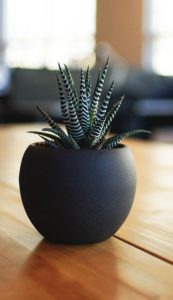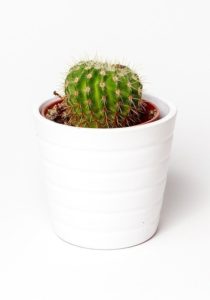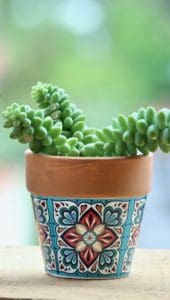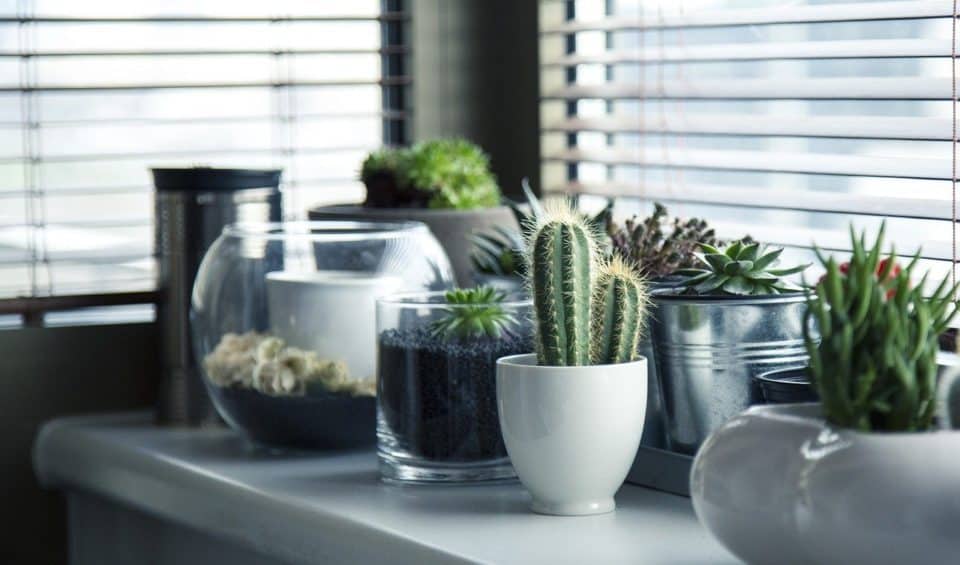Some links in the post are affiliate links and I get a commission from purchases made through some links found in the post.
It’s funny how miniature things always attract attention. Miniature horses, miniature dolls houses, miniature ornaments – the list goes on.
No wonder then that we are attracted to miniature plants for very small pots.
Probably the most common plants to see in a small pot are miniature cacti and succulents.
However, there are many more that stay small and can be grown in coffee mugs teacups, and other very small pots.
Mini Succulents
These lovely little miniatures are simply tiny versions of the average plants. Many of them will stay small for their entire life, while some need to be pruned to keep them small.
If you want more of these plants you can easily break off a piece and stick it another pot.
Can you Keep Plants Small?
 To a certain extent you can keep succulents smaller by propagating.
To a certain extent you can keep succulents smaller by propagating.
Additionally, you can stunt the growth by keeping them out of direct sunlight all day. They will also stay smaller if they are in a cool, dry place.
Small plants are ideal for miniature landscaping projects, and cacti and succulents make great additions. They are easy to obtain by simply take a cutting from another plant.
If you have a friend who has these small plants, you can acquire several different plants for a mini garden.
Tiny flowering plants work well in miniature gardens. Because they are so small they tend to get lost in vast gardens.
Tiny blossoms such as those on forget-me-nots only grow to about 5”. They self-seed and look delightful when placed with other small plants.
Top 5 Plants for Very Small Pots
Here we have 5 plants which are great for very small pots;
1) String of Pearls
2) Zebra Cactus
3) Air Plants
4) Venus Fly Trap
5) Ivy
1) String of Pearls
These interesting plants will hang from small containers or grow on the surface where they will gently crawl along the ground and around other plants.
Pros
- Very adaptable to small pots and mini landscapes
- Spherical leaves maximize water retention
Cons
- Needs trimming back if you don’t want it to pop up elsewhere
- Needs a warm room with filtered light to thrive
2) Zebra Cactus
This is a great addition to any miniature landscape project because of the unique colours. It is an evergreen plant and stays about 6” at full growth.
Pros
- Easy maintenance with watering just once a week in summer, once a fortnight in winter
- Thrives in normal indoor temperatures of between 50°F to 85°F
Cons
- Will die if overwatered so pay attention to the soil, dry is better than wet
3) Air Plants
Air plants must be almost the easiest to maintain. They take their moisture from the air and make great additions to small gardens where they can be seen at their absolute best.
They will grow in virtually any container. You can mount them on a piece of attractive wood or pop them into a soil-free terrarium.
Pros
- Easy maintenance – dip in water once a week
- Slow growth
- No mess from soil
Cons
- If you forget to give them their weekly dip in water they will shrivel up and may not recover
4) Venus Fly Trap
This falls into the ‘novelty plant’ category although it is also regarded as a small plant and can be grown in a small pot or mini garden.
The attraction with these plants is watching them snap closed. Touch the leaves twice and they will snap shut.
Pros
- They do attract flies so apart from being unique, work at keeping flies down
Cons
- Relatively high maintenance, they need peat moss and distilled water
- They prefer cool temperatures and bright light, an unusual combination
5) Ivy
This miniature plant works wonderfully in a tiny garden project, especially when you train it up a small trellis. For best results let the soil dry out until it is almost dry then give a good, deep water.
Pros
- Can be shaped upwards or encouraged to creep on the ground.
Cons
- Is susceptible to spider mites
- Prefers the shade so plan your mini garden with this in mind
Top 5 Outdoor Plants for Very Small Pots
 Not all of us are fortunate enough to have large gardens. Some avid gardeners only have small areas to work with.
Not all of us are fortunate enough to have large gardens. Some avid gardeners only have small areas to work with.
Luckily, there are small plants to fit every nook and cranny, no matter how small the space is.
The advantages of outdoor plants in very small pots are that they tend to be very low maintenance. They need only a little pruning to keep them in shape.
Small plants fit well into alpine gardens and rock gardens where they can happily fill a small place in a container or in the ground.
1) Tiny Monster Geranium
This shrub will grow low and spread. It will reach 8” at the peak of its growth and will produce bright pink flowers late in spring.
Pros
- Excellent ground cover plant
- Works well along borders and edges
Cons
- It may suffer from leaf spot
2) Spider Plant
Make sure that you place your spider in well-drained soil, in a bright sunny place and a great pot.
They are easy to propagate by cutting off the ‘babies’ and rooting them in water before planting them out.
Pros
- Easy to maintain
- Propagates profusely
Cons
- Can look straggly if you leave the ‘babies’ so is better being trimmed
3) Snapdragon
These will grow upright and produce a variety of colours. They look delightful when mixed in with other plants and ideally can be placed at the back as they grow taller.
Pros
- Hardy plants
- They self-seed so you get plants the following year
Cons
- Susceptible to rust and mold so be sure to check frequently
4) Ferns
Ferns are often a part of a miniature garden where they add elegance and beautiful foliage in the right conditions. They prefer to be in partial shade, in fact they are not great sun lovers.
Pros
- Easy to grow and propagate
- Grow well in small pots
Cons
- They must have good drainage otherwise they will not do well
5) Pansies
These are often used to add colour to small gardens, and they produce flowers in many different shades, even variegated blooms.
Pros
- They can last the entire year if kept indoors
- Easy to grow from seed
Cons
- Should be dead headed often otherwise they look neglected
Tips for Creating Your Own Miniature Garden
Creating your own miniature garden can be an extremely rewarding thing. It is also something that you and the kids can do during the school holidays.
There are several different types of miniature garden and there really is no limit to how you design it.
Miniature Fairy Garden
This looks great with succulents and adorned with miniature houses and buildings to look just like a fairy village.
Large Wine Glass Garden
Large wine glasses look delightful when used as centrepieces on the table. They are a great way to grow a variety of small plants, particularly succulents and cacti.
Coffee Mug Garden
If you keep an eye out you will find some quirky coffee mugs which you can use to grow small plants in.
Make an Air Plant Garden
Look out for any unusual containers which can house a few pieces of wood with an air plant resting on it.
As long as you can give the air plant a weekly dip in some water, it will happily be a part of a miniature garden.
Keeping Your Miniature Garden Healthy
It is important that your plants are grown in good drainage potting mix. They are no different from larger plants and must have adequate drainage of they are to survive.
- Pay attention to the individual needs of your mini plants – some will enjoy bright sunlight, while others will prefer shade. Get to know what you can plant in every spot.
- Don’t forget to feed them. Just like bigger plants, small ones also need feeding, although not the same amount as the larger versions. Be sure to check that you are not giving them too much fertiliser.
Final Thoughts: Top 5 Plants for Very Small Pots
 Remember that keeping your small succulents in the shade and watering them less will keep them smaller. Dry and cool is better for these small plants.
Remember that keeping your small succulents in the shade and watering them less will keep them smaller. Dry and cool is better for these small plants.
Depending on the conditions that you plant your small plants in, they can live for the entire year with cacti and succulents living for several years before they need to be re-potted.
Make sure that your small plants in pots always have good drainage so that the water can pass through and not leave the roots waterlogged.
With a little imagination and a few guidelines to follow there is no reason why you should not have one – or even more – of these delightful small gardens.
With a little planning you can have a delightful collection of plants for very small pots.
Before you go, here are some more related articles I encourage you to read below to help solve more of your gardening issues:
Top 15 Houseplants with Red and Green Leaves

